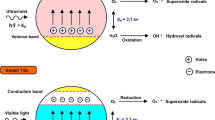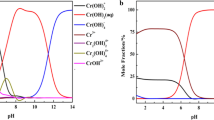Abstract
A kinetic study of the photocatalytic degradation of the pharmaceutical clofibric acid is presented. Experiments were carried out under UV radiation employing titanium dioxide in water suspension. The main reaction intermediates were identified and quantified. Intrinsic expressions to represent the kinetics of clofibric acid and the main intermediates were derived. The modeling of the radiation field in the reactor was carried out by Monte Carlo simulation. Experimental runs were performed by varying the catalyst concentration and the incident radiation. Kinetic parameters were estimated from the experiments by applying a non-linear regression procedure. Good agreement was obtained between model predictions and experimental data, with an error of 5.9 % in the estimations of the primary pollutant concentration.









Similar content being viewed by others
Abbreviations
- a v :
-
Catalytic surface area per unit suspension volume (cm−1)
- C :
-
Molar concentration (mol cm−3)
- BQ:
-
Benzoquinone
- CA:
-
Clofibric acid
- 4-CP:
-
4-Chlorophenol
- C m :
-
Catalyst mass concentration (g cm−3)
- ea :
-
Local volumetric rate of photon absorption (Einstein cm−3 s−1)
- e x :
-
Direction cosine (dimensionless)
- g :
-
Asymmetry factor (dimensionless)
- l :
-
length of flight (cm)
- MC:
-
Monte Carlo
- p :
-
Scattering phase function
- q w :
-
Incident radiation flux (Einstein s−1 cm−2)
- R i :
-
Random number
- RMSE:
-
Root mean square error (%)
- r :
-
Reaction rate (mol cm−3 s−1)
- r gs :
-
Superficial rate of electron-hole generation (mol cm−2 s−1)
- Sg:
-
Specific surface area (cm2 g−1)
- t :
-
Time (s)
- V :
-
Volume (cm3)
- x :
-
Axial coordinate (cm)
- x:
-
Position vector (cm)
- α i , α ′ i :
-
Kinetic parameter
- β :
-
Volumetric extinction coefficient (cm−1)
- ε :
-
Hold-up (dimensionless)
- η ph :
-
number of photons
- ν:
-
Stoichiometric coefficient
- \( \overline{\phi} \) :
-
Wavelength averaged primary quantum yield (mol Einstein−1)
- σ :
-
Volumetric scattering coefficient (cm−1)
- θ :
-
Spherical coordinate (rad)
- ω :
-
Albedo (dimensionless)
- abs:
-
Absorbed
- AR :
-
Catalytic reaction area
- BQ:
-
Benzoquinone
- CA:
-
Clofibric acid
- 4-CP:
-
4-Chlorophenol
- λ :
-
Dependence on wavelength
- HG:
-
Henyey and Greenstein
- R:
-
Reactor
- T:
-
Total
- Tk:
-
Tank
- 0:
-
Initial condition
- < >:
-
Denotes average value over a given space
References
Alfano OM, Cabrera MI, Cassano AE (1997) Photocatalytic reactions involving hydroxyl radical attack I. Reaction kinetics formulation with explicit photon absorption effects. J Catal 172:370–379
Almquist CB, Biswas P (2001) A mechanistic approach to modeling the effect of dissolved oxygen in photo-oxidation reactions on titanium dioxide in aqueous systems. Chem Eng Sci 56:3421–3430
Boyjoo Y, Ang M, Pareek V (2013) Light intensity distribution in multi-lamp photocatalytic reactors. Chem Eng Sci 93:11–21
Changrani R, Raupp GB (1999) Monte Carlo simulation of the radiation field in a reticulated foam photocatalytic reactor. AIChE J 45(5):1085–1094
De la Cruz N, Dantas R, Giménez J, Esplugas S (2013) Photolysis and TiO2 photocatalysis of the pharmaceutical propranolol: solar and artificial light. Appl Catal B Environ 130–131:249–256
Dijkstra MFJ, Panneman HJ, Winkelman JGM (2002) Modeling the photocatalytic degradation of formic acid in a reactor with immobilized catalyst. Chem Eng Sci 57:4895–4907
Doll T, Frimmel F (2004) Kinetic study of photocatalytic degradation of carbamazepine, clofibric acid, iomeprol and iopromide assisted by different TiO2 materials-determination of intermediates and reaction pathways. Water Res 38:955–964
Doll T, Frimmel F (2005) Photocatalytic degradation of carbamazepine, clofibric acid and iomeprol with P25 and Hombikat UV100 in the presence of natural organic matter (NOM) and other organic water constituents. Water Res 39:403–411
Dordio A, Estêvão Candeias A, Pinto A, Teixeira da Costa C, Palace Carvalho A (2009) Preliminary media screening for application in the removal of clofibric acid, carbamazepine and ibuprofen by SSF-constructed wetlands. Ecol Eng 35:290–302
Giraldo A, Peñuela G, Torres-Palma R, Pino N, Palominos R, Mansilla H (2010) Degradation of the antibiotic oxolinic acid by photocatalysis with TiO2 in suspension. Water Res 44:5158–5167
Himmelblau DM (1970) Process analysis statistical methods. Wiley, New York
Imoberdorf G, Taghipour F, Keshmiri M, Mohseni M (2008) Predictive radiation field modeling for fluidized bed photocatalytic reactors. Chem Eng Sci 63:4228–4238
Martínez C, Canle M, Fernández M, Santaballa J, Faria J (2011) Kinetics and mechanism of aqueous degradation of carbamazepine by heterogeneous photocatalysis using nanocrystalline TiO2, ZnO and multi-walled carbon nanotubes–anatase composites. Appl Catal B Environ 102:563–571
Mills A, Morris S, Davies R (1993) Photomineralisation of 4-chlorophenol sensitised by titanium dioxide: a study of the intermediates. J Photochem Photobiol A 70:183–191
Moreira J, Serrano B, Ortíz A, de Lasa H (2010) Evaluation of photon absorption in an aqueous TiO2 slurry reactor using Monte Carlo simulations and macroscopic balance. Ind Eng Chem Res 49:10524–10534
Moreira J, Serrano B, Ortíz A, de Lasa H (2011) TiO2 absorption and scattering coefficients using Monte Carlo method and macroscopic balances in a photo-CREC unit. Chem Eng Sci 66:5813–5821
Murov SL, Carmichael I, Hug GL (1993) Handbook of photochemistry. Marcel Dekker, New York
Pelizzetti E, Minero C (1993) Electrochim Acta 38:47
Salgado R, Oehmen A, Carvalho G, Noronha J, Reis M (2012) Biodegradation of clofibric acid and identification of its metabolites. J Hazard Mater 241–242:182–189
Satuf ML, Brandi RJ, Cassano AE, Alfano OM (2005) Experimental method to evaluate the optical properties of aqueous titanium dioxide suspensions. Ind Eng Chem Res 44:6643–6649
Satuf ML, Brandi RJ, Cassano AE, Alfano OM (2007) Quantum efficiencies of 4-chlorophenol photocatalytic degradation and mineralization in a well-mixed slurry reactor. Ind Eng Chem Res 46:43–51
Siegel R, Howell JR (2002) Thermal radiation heat transfer. Hemisphere, Bristol, PA
Singh M, Salvadó-Estivill I, Li Puma G (2007) Radiation field optimization in photocatalytic monolith reactors for air treatment. AIChE J 53(3):678–686
Spadoni G, Bandini E, Santarelli F (1977) Scattering effects in photosensitized reactions. Chem Eng Sci 33:517–524
Terzian R, Serpone N, Minero C, Pelizzetti E, Hidaka H (1990) Kinetic studies in heterogeneous photocatalysis 4. The photomineralization of a hydroquinone and a catechol. J Photochem Photobiol A 55:243–249
Theurich J, Lindner M, Bahnemann DW (1996) Photocatalytic degradation of 4-chlorophenol in aerated aqueous titanium dioxide suspensions: a kinetic and mechanistic study. Langmuir 12:6368–6376
Turchi CS, Ollis DF (1990) Photocatalytic degradation of organic water contaminants: mechanisms involving hydroxyl radical attack. J Catal 122:178–190
Wu Q, Shi H, Adams C, Timmons T, Ma Y (2012) Oxidative removal of selected endocrine-disruptors and pharmaceuticals in drinking water treatment systems, and identification of degradation products of triclosan. Sci Total Environ 439:18–25
Yokota T, Cesur S, Suzuki H, Baba H, Takahata Y (1999) Anisotropic scattering model for the estimation of light absorption rates in photoreactor with heterogeneous medium. J Chem Eng Jpn 32:314–321
Zazueta A, Destaillats H, Li Puma G (2013) Radiation field modeling and optimization of a compact and modular multi-plate photocatalytic reactor (MPPR) for air/water purification by Monte Carlo method. Chem Eng J 217:475–485
Zekri M, Colbeau-Justin C (2013) A mathematical model to describe the photocatalytic reality: what is the probability that a photon does its job? Chem Eng J 225:547–557
Acknowledgments
The authors are grateful to Universidad Nacional del Litoral (UNL), Consejo Nacional de Investigaciones Científicas y Técnicas (CONICET), and Agencia Nacional de Promoción Científica y Tecnológica (ANPCyT) for financial support. We also thank Antonio C. Negro for his valuable help during the experimental work.
Author information
Authors and Affiliations
Corresponding author
Additional information
Responsible editor: Angeles Blanco
Appendix
Appendix
Considering the competitive adsorption mechanism between CA and their principal intermediates, we can write the following equations:
where [j ads] represents the concentration of the specie j adsorbed on the catalyst surface, K j is the equilibrium adsorption constant, [site j ] represents the superficial concentration of vacant adsorption sites, and C j is the concentration of j in the suspension bulk.
Making a balance of sites we can relate the concentration of vacant sites to the total concentration of sites, [site j,T ]. Balance of absorption sites for O2:
where \( \left[{\mathrm{site}}_{{\mathrm{O}}_2,\mathrm{oc}}\right] \) represent the superficial concentration of occupied sites by O2. Introducing Eq. (21) into Eq. (22):
Balance of absorption sites for the main organic compounds:
Introducing Eq. (18)–(20) in Eq. (25):
Taking to account the assumption (v) made in the Kinetic model, the superficial degradation rate of i specie can be represented by:
where k i is the kinetic constant of the reaction between the organic compound and hydroxyl radicals, [⋅OH] is the concentration of hydroxyl radicals on the surface of the TiO2 particles, and [i ads] represents the superficial concentration of i. Therefore, considering Eq. (27), the degradation pathway depicted in Fig. 3, and the reaction scheme presented in Table 3, the final degradation rate expressions for CA, 4-CP, and BQ are:
Considering the superficial rate of appearance and disappearance of electrons, holes, and hydroxyl radicals shown in Table 3 and applying the kinetic micro-steady state approximation for the concentration of these species, the following expressions are obtained:
where \( {r}_{{\mathrm{e}}^{-}},{r}_{{\mathrm{h}}^{+}}\mathrm{and}\ {r}_{\cdot \mathrm{OH}} \) correspond to the reaction rate of electrons, holes and hydroxyl radicals, respectively.
Operating with Eqs. (31–33) we obtain the expression for [⋅OH]:
Considering assumptions (vi), (vii) and (viii) of the kinetic model and introducing Eq. (34) into Eq. (28) we obtain:
where
Introducing Eq. (18–20) and Eq. (26) in Eq. (35):
Taking into account assumptions (ix) and (x) we obtain the kinetic expression that describes the rate of degradation of CA:
Where
Following the same procedure for 4-CP and BQ, reaction rates expressions were obtained for each of them:
Where
Rights and permissions
About this article
Cite this article
Manassero, A., Satuf, M.L. & Alfano, O.M. Kinetic modeling of the photocatalytic degradation of clofibric acid in a slurry reactor. Environ Sci Pollut Res 22, 926–937 (2015). https://doi.org/10.1007/s11356-014-2682-5
Received:
Accepted:
Published:
Issue Date:
DOI: https://doi.org/10.1007/s11356-014-2682-5




